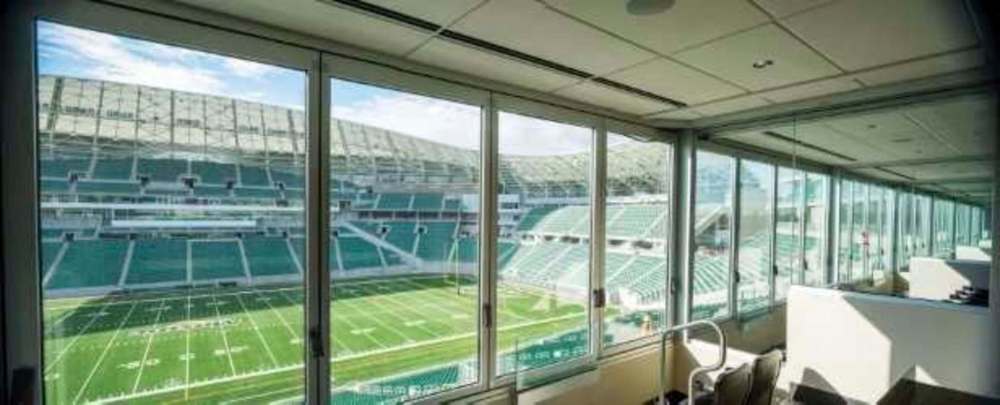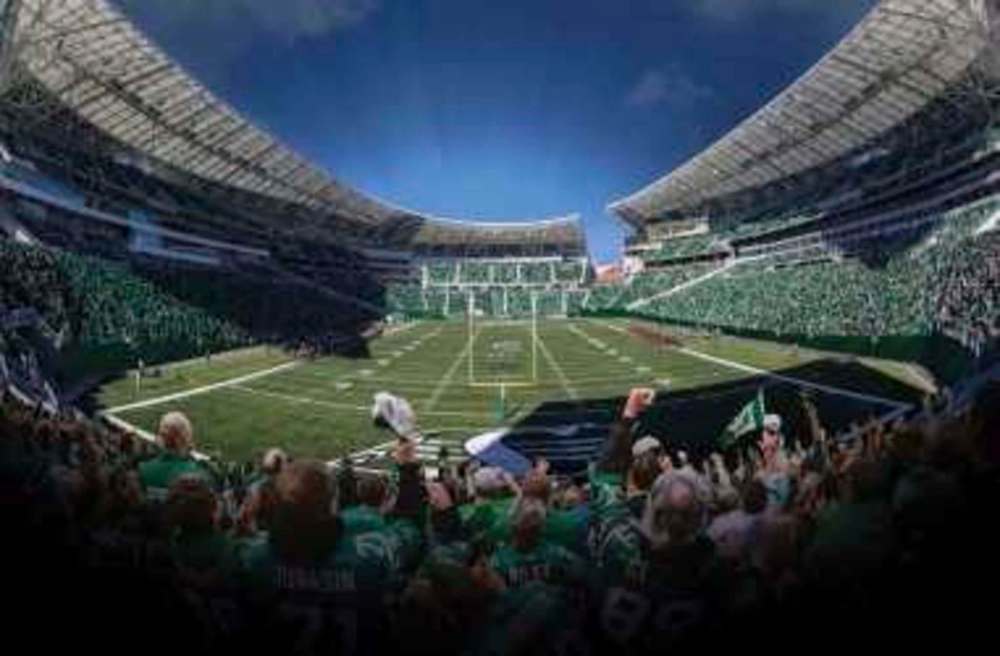Big stadium on the Prairie
After a decade in the making, Roughriders unveil new Mosaic Stadium
Advertisement
Read this article for free:
or
Already have an account? Log in here »
To continue reading, please subscribe:
Monthly Digital Subscription
$1 per week for 24 weeks*
- Enjoy unlimited reading on winnipegfreepress.com
- Read the E-Edition, our digital replica newspaper
- Access News Break, our award-winning app
- Play interactive puzzles
*Billed as $4.00 plus GST every four weeks. After 24 weeks, price increases to the regular rate of $19.00 plus GST every four weeks. Offer available to new and qualified returning subscribers only. Cancel any time.
Monthly Digital Subscription
$4.75/week*
- Enjoy unlimited reading on winnipegfreepress.com
- Read the E-Edition, our digital replica newspaper
- Access News Break, our award-winning app
- Play interactive puzzles
*Billed as $19 plus GST every four weeks. Cancel any time.
To continue reading, please subscribe:
Add Free Press access to your Brandon Sun subscription for only an additional
$1 for the first 4 weeks*
*Your next subscription payment will increase by $1.00 and you will be charged $16.99 plus GST for four weeks. After four weeks, your payment will increase to $23.99 plus GST every four weeks.
Read unlimited articles for free today:
or
Already have an account? Log in here »
Hey there, time traveller!
This article was published 02/07/2017 (3024 days ago), so information in it may no longer be current.
REGINA — In February, Craig Reynolds, president and CEO of the Saskatchewan Roughriders, called a meeting with his staff in the boardroom at the new Mosaic Stadium. The team had just moved into its new offices and it was time to get down to business on what was just the beginning of a very busy season ahead.
As people started to gather and take their seats, for Reynolds, it symbolized not only the bright future of the CFL franchise he looks over, but also the years of hard work that had been put in leading up to this point. Having been there from the beginning — first as the executive lead of the stadium project, now as the face of its main tenant — Reynolds couldn’t help but bask in the glory that now surrounded him.
After close to decade of labour, a collective effort that included co-operation from both levels of local government, the team and the fan base, he finally gave himself a chance to embrace his new home.

“That’s when I had my moment,” Reynolds said in an interview with the Free Press Friday. “I just looked out at the stadium and said, ‘I can’t believe what we’ve accomplished here.’”
The field and most of the 33,000 seats that make up the new Mosaic Stadium — a $278.2-million facility that happens to be a football throw away from the old Mosaic Stadium, where the Roughriders played for the better part of the past 80 years — was covered in snow and still under construction. What caught Reynolds’ eye, however, was the Maxtron, the largest single LED video board in the CFL. The giant screen is the equivalent of watching 540 60-inch televisions. It spans 40 yards in width and its height equals four football goal posts.
“It’s been a long process, but a fun one,” Reynolds added.
If the massive video screen seems grandiose, it doesn’t look out of place. When the city, the province and the Roughriders got together nearly 10 years ago, the plan was to make Mosaic Stadium a new home not only for football fans, but also the entire community. So they dreamed big, believing in a project they felt could not only be one of the country’s top entertainment facilities, but a chance to put Regina — a small Prairie city often lost on those who’ve never visited — on the world stage.
“We think we have the best fans in the league and we think they deserve the best facility in the league,” Reynolds said. “So that was our vision.”
Erected near the south end zone, it stands behind a social standing area — called Pil Country, which is named after Pilsner beer, a major team sponsor — where 1,500 fans, all 19 years or older, can gather while resting their drinks on a table in a relaxed atmosphere.
For others, there are premium-seating options, including a two-level, fully enclosed lounge. A general admission lounge, facing out onto the newly renovated Confederation Park on the west side of the stadium, can be accessed by anyone. In total, there are 38 corporate suites — 20 of which feature removable windows.
Then there is team’s area, a space that totals 67,360 square feet. The players are treated to a locker room unlike any in the CFL. In total, there are 72 lockers, each equipped with a green-lit storage bin — known as the “jewel box” — for their helmets, as well as lots of space to keep their equipment (also installed is a forced-air system that helps tackle odours).
Nearby is an athletic therapy room that includes three tubs — a hot one, a cold one and one with an underwater treadmill. Move down the hall and you’ll find a weight room outfitted with state-of-the art equipment, including a stretch of artificial turf that is four yards wide and 22 yards long. There’s a barber’s chair across the hallway, where players can get a trim (though it appears to be just for show, with no hired barber on site).
“Being around this league and being on other teams makes you appreciate this building,” said Roughriders quarterback Kevin Glenn, now in his 17th season and third stint in Saskatchewan. “The guys, they appreciate this locker room, they appreciate the stadium and they appreciate the fans. You can tell that by what they’re doing when they’re in here, the type of commitment that they’re putting towards going out and trying to put a good product out on the field.”
In discussions with architects, the Roughriders had one main objective: that the stadium be as unique as the city it’s in, a reflection of its values and culture. To achieve these high standards, they partnered with HKS Architects, a firm known to be among the best when it comes to building and designing sports stadiums. Among their many projects includes AT&T Stadium, the US$1.3-billion home to the Dallas Cowboys.

“We do a very deep dive and try to do and understand as much as we can. In this case, it was about the province, about the CFL, about the city of Regina, about the people that come into this building on a daily basis,” Mark Williams, stadium design head at HKS, said. “We do a very serious analysis and we try to understand that at a very deep level and then the beautiful thing that happens is you don’t know what’s going to grow out of that but what grows out of that is, it becomes the DNA of the region. And that’s what this stadium represents.”
He added: “The loyalty, the energy and just how much Mosaic Stadium means to this city, it takes you about three-and-a-half minutes to start to feel that and it takes three-and-a-half months before you really understand that.”
Along with Williams’ intense commitment — he visited three regular season games at the old Mosaic Stadium before winning the bid — was Reynolds’ desire to get inspired by what other markets were doing. Over the span of a few years, he visited 24 different venues across a number of different sports, trying to get an idea of the newest trends and uncover best-kept secrets. Every place he visited, Reynolds said, played a role in the building of the new Mosaic. He also visited Winnipeg on a number of occasions — as well as other CFL cities — to find out what worked and didn’t work in their construction process.
“Pretty much with everything in the stadium, I could tell you, if we walked it, where it came from,” Reynolds said.
On Saturday evening, when the Roughriders hosted the Winnipeg Blue Bombers in their home opener, it was just the fourth time the stadium had hosted an event. Though thousands have already seen what the stadium has to offer, the previous events — a university football game, music concerts and a pre-season tilt against the Bombers — were considered dry runs. The football game is when they finally showed it off to the world, broadcast on live TV for all to see.
“Sometimes you have to just step back and really think about what a great day it is,” Reynolds said. “I was asked on Monday if it’s the one of the biggest days in the history of the franchise, and I believe that. It’s that big. Only once in a lifetime will we open a facility like this and it’s world-class and iconic.”
jeff.hamilton@freepress.mb.ca twitter: @jeffkhamilton

Jeff Hamilton
Multimedia producer
Jeff Hamilton is a sports and investigative reporter. Jeff joined the Free Press newsroom in April 2015, and has been covering the local sports scene since graduating from Carleton University’s journalism program in 2012. Read more about Jeff.
Every piece of reporting Jeff produces is reviewed by an editing team before it is posted online or published in print — part of the Free Press‘s tradition, since 1872, of producing reliable independent journalism. Read more about Free Press’s history and mandate, and learn how our newsroom operates.
Our newsroom depends on a growing audience of readers to power our journalism. If you are not a paid reader, please consider becoming a subscriber.
Our newsroom depends on its audience of readers to power our journalism. Thank you for your support.


